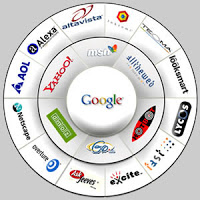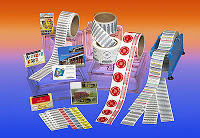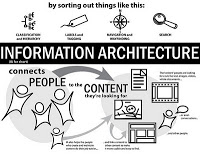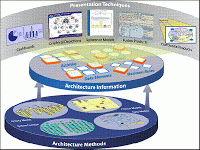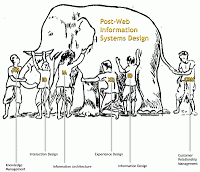Information Architecture
Information Architecture
Information architecture is the term used to describe the structure of a system, i.e the way information is grouped, the navigation methods and terminology used within the system. An effective information architecture enables people to step logically through a system confident they are getting closer to the information they require. Information architecture is most commonly associated with websites and intranets, content management systems, but it can be used in the context of any information structures or computer systems.
Information architecture involves the categorization of information into a coherent structure, preferably one that the intended audience can understand quickly, if not inherently, and then easily retrieve the information for which they are searching. The organization structure is usually hierarchical.
Information architecture is defined by the Information Architecture Institute as the art and science of organizing and labeling web sites, intranets, online communities, and software to support findability and usability.
Information architecture is the term used to describe the structure of a system, i.e the way information is grouped, the navigation methods and terminology used within the system. An effective information architecture enables people to step logically through a system confident they are getting closer to the information they require. Information architecture is most commonly associated with websites and intranets, content management systems, but it can be used in the context of any information structures or computer systems.
Information architecture involves the categorization of information into a coherent structure, preferably one that the intended audience can understand quickly, if not inherently, and then easily retrieve the information for which they are searching. The organization structure is usually hierarchical.
Organizing functionality and content into a structure that people are able to navigate intuitively doesn’t happen by chance. Organizations must recognize the importance of information architecture or else they run the risk of creating great content and functionality that no one can ever find. Most people only notice information architecture when it is poor and stops them from finding the information they require.
An effective information architecture comes from understanding business objectives and constraints, the content, and the requirements of the people that will use the site.
Information architecture is often described using the following diagram:

Business/Context
Understanding an organisations’ business objectives, politics, culture, technology, resources and constraints is essential before considering development of the information architecture. Techniques for understanding context include:
*reading existing documentation;
*mission statements, organisation charts, previous research and vision documents are a quick way of building up an understanding of the context in which the system must work;
*stakeholder interviews;
*speaking to stakeholders provides valuable insight into business context and can unearth previously unknown objectives and issues.
Content
The most effective method for understanding the quantity and quality of content (i.e. functionality and information) proposed for a system is to conduct a content inventory. Content inventories identify all of the proposed content for a system, where the content currently resides, who owns it and any existing relationships between content. Content inventories are also commonly used to aid the process of migrating content between the old and new systems.
Users
An effective information architecture must reflect the way people think about the subject matter. Techniques for getting users involved in the creation of an information architecture include card sorting and card-based classification evaluation.
Card sorting involves representative users sorting a series of cards, each labelled with a piece of content or functionality, into groups that make sense to them. Card sorting generates ideas for how information could be grouped and labelled. For further information about card sorting, see the article “Card sorting a definitive guide”
Card-based classification evaluation is a technique for testing an information architecture before it has been implemented. The technique involves writing each level of an information architecture on a large card, and developing a set of information-seeking tasks for people to perform using the architecture.
More about information architecture next time...
Information Architecture and Usability
Information Architecture Components - Navigation Systems
Information Architecture Components - Search Systems
Information Architecture Components – Labeling Systems
In this post, I am going to describe labeling systems.
Information Architecture Components – Organization Systems
Information Architecture for Web Sites
Single Page
Information Architecture Methods
Information Architecture Styles
Is Your Web Site Optimized for Mobile Devices?
Many people are highly dependent of their mobile devices for every day interactions, including mobile commerce. Our society is becoming highly mobile and connected. In the latest Shop.org and Forrester Research Mobile Commerce Survey, it's estimated that U.S. smartphone commerce will grow to $31 billion by 2016.
Those organizations that can best serve mobile customers will have an advantage in the competition. With a surge in mobile traffic comes the added potential to connect with and sell to customers through mobile commerce. Having a concrete mobile infrastructure plan and strategy is no longer an option, as it had been in recent years, but rather a must to compete in any customer-facing situation.
Methods and Techniques for Information Architecture Design
Realities of Online Self-Service
Successful Self-Service Strategy
When it comes to customer service, simplicity is critical. Companies can improve customer experiences primarily by limiting the amount of effort it takes for customers to find answers to their questions and accomplish their tasks. Here lies the appeal of Web self-service, which for many consumers has become the preferred communication channel.
Instantly available, 24/7 online customer self-service portals are gaining ground over conventional agent-assisted support, marking a significant shift in consumer attitudes toward the technology. And, contrary to popular belief, interest in Web self-service technologies is not just coming from younger consumers. The technology is changing the behavior of consumers of all generations. In fact, a recent study by Forrester Research found that 72 percent of consumers,regardless of age, prefer self-service to picking up the phone or sending an email when it comes to resolving support issues. This certainly is welcome news for organizations looking to cut customer service costs and maximize revenue.
What is Usability and How Does it Relate to Business?
Your business is relying more heavily on technology than it ever has, and it is likely to continue in that direction. But in order for your technology to work for your business and make it successful, there must be at least some degree of usefulness to your technology. That may sound like a no-brainer at first, considering that it is the entire reason your business has adopted technology. However, a surprising number of enterprises fail to adhere to usability and user design principles. Usability, as it suggests, is the field of studying a document’s usefulness to the user. How easy is the website to navigate? Is there enough white space? Is information structured logically? Are elements easy to find? These are just some of the questions a usability test might attempt to answer.









